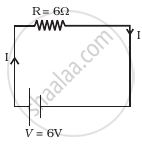Advertisements
Advertisements
प्रश्न
Derive an expression for drift velocity of free electrons in a conductor in terms of relaxation time.
उत्तर
If there are N electrons and the velocity of the ith electron at a given time is vi where, i = (1, 2, 3, …N), then
`1/N sum_(i-1)^N V_1 = 0` (If there is no external field)
When an external electric field is present, the electrons will be accelerated due to this field by
`veca = (-evecE)/m`
Where,
− e = Negative charge of the electron
E = External field
m = Mass of an electron
Let vi be the velocity immediately after the last collision after which external field was experienced by the electron.
If vi is the velocity at any time t, then from the equation V = u + at, we obtain
`vecV_i = vecv_i - (evecE)/m t ........ (1)`
For all the electrons in the conductor, average value of vi is zero.
The average of vi is vd or drift velocity.
This is the average velocity experienced by an electron in an external electric field.
There is no fixed time after which each collision occurs. Therefore, we take the average time after which one collision takes place by an electron.
Let this time, also known as relaxation time, beτ. Substituting this in equation (i)
`vecv_i - o`
`t = tau`
`vecV_i = vecv_d`
Then,
`vecv_d = (-evecE)/m`
Negative sign shows that electrons drift opposite to the applied field.
APPEARS IN
संबंधित प्रश्न
Write its (‘mobility’ of charge carriers) S.I. unit
(a) drift speed
(b) current density
(c) electric current
(d) electric field
When electrons drift in a metal from lower to higher potential, does it mean that all the free electrons of the metal are moving in the same direction?
Define relaxation time of the free electrons drifting in a conductor. How is it related to the drift velocity of free electrons? Use this relation to deduce the expression for the electrical resistivity of the material.
When a current is established in a wire, the free electrons drift in the direction opposite to the current. Does the number of free electrons in the wire continuously decrease?
Electrons are emitted by a hot filament and are accelerated by an electric field, as shown in the figure. The two stops at the left ensure that the electron beam has a uniform cross-section.

Consider the following statements.
(A) Free-electron density is different in different metals.
(B) Free-electron density in a metal depends on temperature.
Thomson Effect is caused _______________ .
At room temperature, copper has free electron density of 8.4 × 1028 per m3. The copper conductor has a cross-section of l0−6 m2 and carries a current of 5.4 A. The electron drift velocity in copper is:
- Consider circuit in figure. How much energy is absorbed by electrons from the initial state of no current (ignore thermal motion) to the state of drift velocity?
- Electrons give up energy at the rate of RI2 per second to the thermal energy. What time scale would one associate with energy in problem (a)? n = no of electron/volume = 1029/m3, length of circuit = 10 cm, cross-section = A = (1mm)2

The potential difference applied across a given conductor is doubled. How will this affect (i) the mobility of electrons and (ii) the current density in the conductor? Justify your answers.
